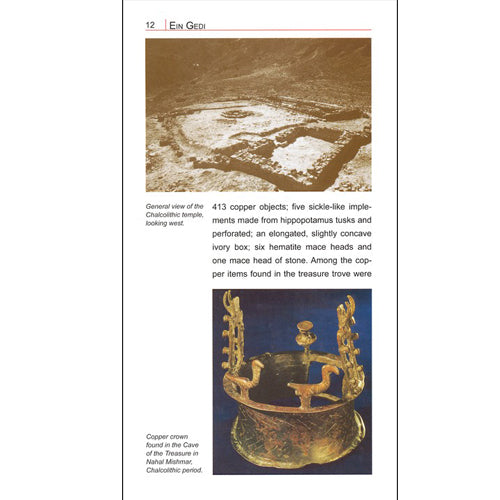Ein Gedi - Oasis and Refuge - Field Guide from Carta
Ein Gedi - Oasis and Refuge - Field Guide from Carta
SKU: PB405
Couldn't load pickup availability
This lavishly illustrated and clear and easy-to-use guide takes us through the history of Ein Gedi, followed by a description of hiking trails and principal sites that may be visited in and around the oasis.
Ein Gedi is Israel's largest oasis off the western shore of the Dead Sea. Within the oasis, there are four springs which together supply 3 million cubic meters of water annually. The location, high temperatures, and abundance of water produce a wide variety of plant and animal life, some of which are quite rare.
Inhabited as early as the Chalcolithic period, in the fourth millennium BCE, Ein Gedi is mentioned in the biblical narrative of the pursuit of David by King Saul. Beginning in the 7th century BCE, Ein Gedi was almost continuously settled for some 1,400 years. During the excavations (1961-1965) conducted at Tel Goren, the ancient mound of Ein Gedi, strata from the end of the First Temple period (late 7th century BCE) until the end of the Second Temple period (1st century CE) were uncovered. During the Late Roman and Byzantine periods, residential quarters were built here along with the most important structure discovered - a synagogue from the 4th century CE.
Excerpt:
"Above Ein Gedi, on the slope between Nahal Arugot and Nahal David, there is a large temple which was built in the Chalcolithic period. This is the only temple from this period that has been discovered in the country."
This lavishly illustrated and clear and easy-to-use guide takes us through the history of Ein Gedi, followed by a description of hiking trails and principal sites that may be visited in and around the oasis.
Contents:
- Introduction
- A Historical Survey of Ein Gedi
- The Chalcolithic Period
- The Biblical Period
- The Persian Period
- The Village of Ein Gedi within the Oasis
- Ein Gedi between the Destruction of the Second Temple and the Bar Kokhba Revolt
- Ein Gedi During the Late Roman and Byzantine Period
- Ein Gedi in the Early Arab Period
- Revival of Ein Gedi in the Twentieth Century
- A Tour of Ein Gedi
- The Area North of Ein Gedi
- The Sabar and Other Caves North of the Field School
- The Hermit Cave
- Trails to the Desert Plateau
- The Har Yishai Cave
- The Tzafit Trail
- The Cave of the Pool
- \The Lower Part of Nahal David and the Dodim Cave
- The Cahlcolithic Temple
- The Ein Gedi Spring
- The Cells Site
- Metzad Arugot
- Tel Goren
- The Ancient Synagogue of Ein Gedi
- Nahal Arugot
- Around Ein Gedi (Azaria Alon)
- Select Sources
- Picture Sources
- Index
Hanan Eshel is Associate Professor and former head (2002-2004) of the Department of Land of Israel Studies and Archaeology at Bar-Ilan University, Israel. He received his Ph.D. in Jewish History from The Hebrew University of Jerusalem. Among his many honors, he was awarded a Fulbright Fellowship and a Harry Starr Fellowship at Harvard University, and was visiting lecturer in Late Second Temple Judaism at Harvard Divinity School.
Dr. Eshel has directed a number of excavations in Israel, including Qumran and Ein Gedi. His publications include The Bar-Kokhba Refuge Caves (Hebrew) and The Dead Sea Scrolls and the Hasmonean State (Grand Rapids 2008), and over 200 articles.
Product Details:
- Language: English
- Soft Cover
- 144 pages
- 4 3/4×8½ in. (12×21.5 cm)
Additional Information
Additional Information
Share









